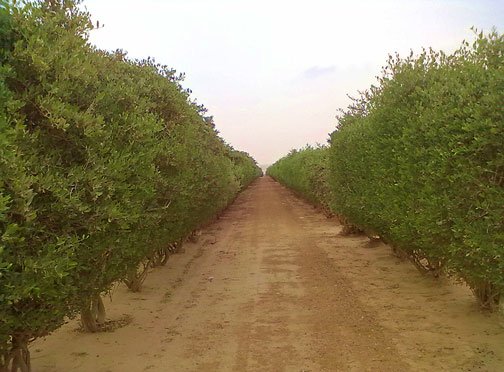- Share this article
- Subscribe to our newsletter
Climate change: plantations sequester CO2 and bring rain to the desert
Good news at a time dominated by negative reports on human influence on the global system. “Large plantations, for example of jojoba plants, significantly increase the share of solar energy absorbed by the Earth’s surface,” explains earth system scientist Dr Oliver Branch at Hohenheim University in Stuttgart, Germany. “The plants largely release the energy in the form of heat to the immediate atmosphere,” the researcher continues. As a result, a warm low-pressure area forms in the desert a so called thermal or heat low. “The pressure differentials around the plantations create areas of rising air which can result in cloud formation and precipitation.”
The plantations can accordingly create rain in the desert, positively influencing the regional climate. “Naturally, we can only change the global climate when CO2 absorption reaches a global level,” comments Professor Volker Wulfmeyer, who co-supported the research project. “But in this way, we can at least influence the weather, and make living in arid and hot areas more tolerable for humans.”
Global Feedback Index: simulation shows the most suitable areas
The strength of the effect depends on the region and season. “If and how well cloud formation and precipitation work depend on a lot of factors,” Oliver Branch explains. For example, the prevailing wind speeds and the properties of the soil are decisive.
Thanks to a new technique, this can be quantified for the first time, bringing focus on motivating and monitoring reafforestation measures. Using simulations, Dr Branch developed a Global Feedback Index, which can be used to identify areas which are suitable for precipitation-promoting plantations. “Examples of areas with a high index level include the Arabian Peninsula, Namibia and the Sahara. We are planning further simulations for these regions,” the researcher explains.
Based on meteorological data for the past 40 years, Hohenheim researchers have developed monthly maps for the Earth. Different variables can be used in this way to determine reliably where these cloud- and precipitation-forming methods can work, Oliver Branch emphasised.
The scientists talk about bio-geoengineering, - a term used to describe methods that seek to optimise the global climate by affecting the biosphere. “Every arid area is different,” Dr Branch notes. “Whereas a hundred square kilometre plantation in Oman would make a major difference and form clouds, this would have no effect whatsoever in Israel, for example.”
Jojoba – a plant with many benefits
The choice of plants is important. Jojoba bushes are particularly suitable, because they sequester large amounts of CO2 as they grow, and can withstand high temperatures. As a result, they contribute to so-called negative emissions, capturing CO2 from the atmosphere. “In this way the plantations can mitigate the effects of the climate crisis, and at the same time counter its progress,” Dr Branch summarises. The plants also hardly transpire at all during the day, so that the warm low-pressure effect is particularly marked.
Besides the positive climatic properties, jojoba plantations benefit the local population in many ways. “For example, jojoba can be used to produce a high-quality oil which is in great demand on the market,” Dr Birch notes. The biomass can also be used as a renewable material in energy generation.
The new publication shows that our understanding of complex feedback processes has now reached the point where we can have a quantitative influence on regional weather and climate. The Hohenheim University project is a new approach to using bio-geoengineering to tackle one of the most urgent challenges of our times – influencing the weather and climate for the benefit of humanity.
(Hohenheim University/wi)
Reference:
Deliberate Enhancement of Rainfall using Desert Plantations
DOI: https://www.pnas.org/content/early/2019/08/27/1904754116





Add a comment
Be the First to Comment